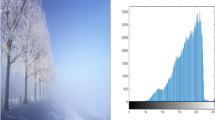Abstract
Image enhancement is a technique that manipulates an image to make it more meaningful and effective to user specific problem. In most of the enhancement techniques, input image intensities are transformed into either higher order or lower order intensities according to the designed algorithmic characteristic. But, in certain cases the input intensities might require to be transformed in a balanced combination of both higher and lower order intensity. Moreover, 2D Geometric Transformation is mainly used to transform the objects presents in an image. Here a contemplative fusion of gamma and 2D Geometric Transformation concept has been used for intensity transformation. The proposed method first divides the histogram into three sub-sections according to the homogeneity value representing the dark, gray and bright section of histogram. Then each sub-section is transformed locally using adaptive gamma and 2D Geometric scaling transformation. These transformed sub-sections are merged again by employing 2D translation operation. On the other hand, a global gamma transformation is obtained for entire histogram. At last, the final transformation matrix is obtained by combining previously computed local and global transformation. The comparison of this technique with other state of art technique has been discussed to depict the significance of the proposed method. The proposed method gives a new and innovative dimension of image enhancement.




















Similar content being viewed by others
References
Cao G, Huang L, Tian H, Huang X, Wang Y, Zhi R (2018) Contrast enhancement of brightness-distorted images by improved adaptive gamma correction. Computers & Electrical Engineering 66:569–582. https://doi.org/10.1016/j.compeleceng.2017.09.012
Chen Y, Tao J, Liu L, Xiong J, Xia R, Xie J, Zhang Q, Yang K (2020) Research of improving semantic image segmentation based on a feature fusion model, Journal of Ambient Intelligence and Humanized Computing. https://doi.org/10.1007/s12652-020-02066-z
Chen Y, Xu W, Kuang F, Gao S (2013) The research and application of visual saliency and adaptive support vector machine in target tracking field. Computational and Mathematical Methods in Medicine 2013:1–8. https://doi.org/10.1155/2013/925341
Chen Y, Xu W, Zuo J, Yang K (2018) The fire recognition algorithm using dynamic feature fusion and IV-SVM classifier. Clust Comput 22 (S3):7665–7675. https://doi.org/10.1007/s10586-018-2368-8
Cheng HD, Zhang Y (2012) Detecting of contrast over-enhancement. In: 2012 19th IEEE International Conference on Image Processing. https://doi.org/10.1109/icip.2012.6467021. IEEE
Gonzalez RC, Woods RE (2018) Intensity transformations and spatial filtering. In: Digital Image Processing, Pearson Education India, pp 119–127
HEARN BAKER (1997) Computer graphics c version 2nd edition, pearson india
Huang S-C, Cheng F-C, Chiu Y-S (2013) Efficient contrast enhancement using adaptive gamma correction with weighting distribution. IEEE Transactions on Image Processing 22(3):1032–1041. https://doi.org/10.1109/tip.2012.2226047
Huang Z, Fang H, Li Q, Li Z, Zhang T, Sang N, Li Y (2018) Optical remote sensing image enhancement with weak structure preservation via spatially adaptive gamma correction. Infrared Physics & Technology 94:38–47. https://doi.org/10.1016/j.infrared.2018.08.019
Huang Z, Zhang T, Li Q, Fang H (2016) Adaptive gamma correction based on cumulative histogram for enhancing near-infrared images. Infrared Physics & Technology 79:205–215. https://doi.org/10.1016/j.infrared.2016.11.001
Hussain K, Rahman S, Rahman MM, Khaled SM, Wadud MA-A, Khan MAH, Shoyaib M (2018) A histogram specification technique for dark image enhancement using a local transformation method. IPSJ Transactions on Computer Vision and Applications 10(1):3. https://doi.org/10.1186/s41074-018-0040-0
Jain AK (2015) Fundamentals of digital image processing, pearson education india, 233–243
Kaiser PK (2017) The joy of visual perception. Accessed: 2010-09-30
Kallel F, Hamida AB (2017) A new adaptive gamma correction based algorithm using DWT-SVD for non-contrast CT image enhancement. IEEE Transactions on NanoBioscience 16(8):666–675. https://doi.org/10.1109/tnb.2017.2771350
Kallel F, Sahnoun M, Hamida AB, Chtourou K (2018) CT scan contrast enhancement using singular value decomposition and adaptive gamma correction. SIViP 12(5):905–913. https://doi.org/10.1007/s11760-017-1232-2
Kim Y-T (1997) Contrast enhancement using brightness preserving bi-histogram equalization. IEEE Transactions on Consumer Electronics 43(1):1–8. https://doi.org/10.1109/30.580378
Lu X, Ma C, Ni B, Yang X (2019) Adaptive region proposal with channel regularization for robust object tracking, IEEE Transactions on Circuits and Systems for Video Technology, 1–1. https://doi.org/10.1109/tcsvt.2019.2944654
Mandal A, Sarkar K, Sarkar S (2018) Histogram peak least center distance based threshold to segment brain tumor from t1 weighted contrast enhanced mri. International Journal of Modern Electronics and Communication 6(4):35–43. http://www.ijmece.org/issues/IJMECE180720.pdf
Perry D (2012) intro to image processing. Accessed: 2020-08-22
Qureshi MA, Sdiri B, Deriche M, Alaya-Cheikh F, Beghdadi A (2017) Contrast enhancement evaluation database ceed2016, v3, mendeley data. https://doi.org/10.17632/3hfzp6vwkm.3
Rahman S, Rahman MM, Abdullah-Al-Wadud M, Al-Quaderi GD, Shoyaib M (2016) An adaptive gamma correction for image enhancement. EURASIP Journal on Image and Video Processing 2016 (1):1–13. https://doi.org/10.1186/s13640-016-0138-1
Reddy ME, Reddy GR (2020) Recursively partitioned clipped histogram equalization techniques for preserving image features. In: Proceedings of the National Academy of Sciences, India Section A: Physical Sciences. https://doi.org/10.1007/s40010-020-00670-4
Sahnoun M, Kallel F, Dammak M, Kammoun O, Mhiri C, Mahfoudh KB, Hamida AB (2019) Spinal cord MRI contrast enhancement using adaptive gamma correction for patient with multiple sclerosis, SIViP. https://doi.org/10.1007/s11760-019-01561-x
Sinecen M (2016) Digital image processing with MATLAB. In: Applications from Engineering with MATLAB Concepts, InTech. https://doi.org/10.5772/63028
Sonka M, Hlavac V, Boyle R (1993) Image pre-processing. In: Image Processing, Analysis and Machine Vision, Springer US, 56–111. https://doi.org/10.1007/978-1-4899-3216-7
Tsai C-M, Yeh Z-M, Wang Y-F (2009) Decision tree-based contrast enhancement for various color images. Mach Vis Appl 22(1):21–37. https://doi.org/10.1007/s00138-009-0223-x
Veluchamy M, Subramani B (2019) Image contrast and color enhancement using adaptive gamma correction and histogram equalization. Optik 183:329–337. https://doi.org/10.1016/j.ijleo.2019.02.054
VIMAL SP, THIRUVIKRAMAN PK (2012) Automated image enhancement using power law transformations. Sadhana 37 (6):739–745. https://doi.org/10.1007/s12046-012-0110-4
Author information
Authors and Affiliations
Corresponding author
Additional information
Publisher’s note
Springer Nature remains neutral with regard to jurisdictional claims in published maps and institutional affiliations.
Rights and permissions
About this article
Cite this article
Sarkar, K., Halder, T.K. & Mandal, A. Adaptive power-law and cdf based geometric transformation for low contrast image enhancement. Multimed Tools Appl 80, 6329–6353 (2021). https://doi.org/10.1007/s11042-020-10004-6
Received:
Revised:
Accepted:
Published:
Issue Date:
DOI: https://doi.org/10.1007/s11042-020-10004-6




